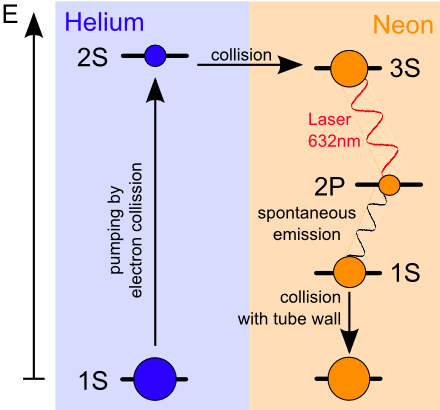2. Laser
Circumventing the thermodynamic equilibrium
The method which is used to disturb the thermal equilibrium between the laser niveaus in order to achieve a population inversion is called pumping. In the HeNe laser, the electrons accelerated in the gas discharge provide the energy needed to stimulate the Helium atoms into an excited, metastable 2S state (metastable states have a comparatively very long life time).
As soon as the Helium has reached the 2S state, a collision of a second kind can follow. This is a collision between two atoms wherein not only kinetic energy but also the excitation energy is transferred. This is possible because Helium's 2S state and Neon's 3S state have very similar excitation energy levels. The collision results in a specific enrichment of the Neon 3S state against its 2P state. And because Helium is more concentrated than Neon, a population inversion can take place.
Laser light is emitted through transitions from the 3S state into the 2P state of the Neon atoms. The 2P state is short-lived and shifts quickly into the 1S state. This one is quite stable but it becomes unstable when it collides with the glass tube's walls. An adequate amount of collisions should occur continuously, otherwise the laser emission will cease. This is the reason why the diameter of the gas discharge tube should not exceed 1 mm.

